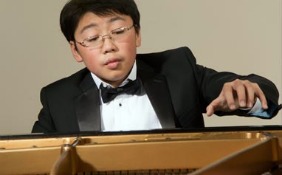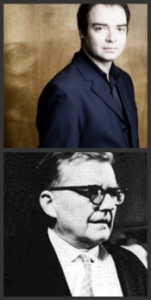George Li
Programme Notes
Performance: Vancouver Playhouse, Sunday, December 4, 2011
Carl Czerny
Variations on a Theme by Rode, Op. 33 (“La Ricordanza”)
Most concertgoers know Carl Czerny only as the early nineteenth-century pedagogue who churned out endless dull exercises that continue to be inflicted upon piano students this day. True, he did compose a tremendous amount – 861 opus numbers and an even greater amount published without opus numbers – and true, the exercises are dull. But Czerny composed much else that is decidedly not dull.
Unlike his teacher Beethoven, and unlike his star pupil Franz Liszt, Czerny was no innovator, but within the parameters of his time much of his music is eminently pleasing, charming, tasteful and sensitively written. He wrote voluminously in nearly every known form and genre of the time: sonatas, fantasias, theme and variation sets, piano concertos, symphonies, sacred choral music, string quartets and much other chamber music. His most frequently recorded composition would seem to be an Andante and Pollaca for horn and piano, with the Variations on this afternoon’s program not far behind.
The variation form and its close cousin the fantasia were immensely popular in the early nineteenth century. Beethoven wrote some twenty sets of variations for piano. Czerny mined dozens of operas, symphonies, overtures, oratorios and ballets by Beethoven, Bellini, Cherubini, Donizetti, Handel, Haydn, Mendelssohn, Mozart, Rossini, Verdi, Wagner, Weber and others for his variation sets and fantasias. From the famous French violinist Pierre Rode (1774-1830) he borrowed the tune “La Ricordanza” and set it as a theme with five variations for solo piano. A stately one precedes the final and most brilliant variation, which in turn is followed by a return to the theme for a quiet closing.
Arnold Schoenberg
Sechs kleine Klavierstücke (Six Little Piano Pieces), Op. 19
Schoenberg, unlike the other composers represented on this program, was not a keyboard virtuoso. Nevertheless, he turned to the piano as a medium of experimentation on more than one occasion. One such occasion came in 1909, when he produced his first atonal composition, the Three Piano Pieces, Op. 11.
Essentially what Schoenberg achieved in these pieces was the emancipation of dissonance from its ties to traditional harmony. A “dissonant” note or chord no longer had any contextual relationship to surrounding pitches; it existed in and of itself. It is traditional to view these pieces as a milestone, a break with the past, a giant step forward in the development of music history. Yet Schoenberg always regarded this music as an absolutely logical continuation of the past, something “distinctly a product of evolution, and no more revolutionary than any other development in the history of music.”
Schoenberg’s next piano music, Op. 19, appeared in 1911. But whereas the three pieces of Op. 11 require about a quarter of an hour to perform, the six pieces of Op. 19 require barely five minutes. “A novel in a sigh” was the expression coined for such pieces.
Continuing where he left off in Op. 11, Schoenberg made the non-recurrence of thematic material the operating principle in Op. 19. The dynamic level is also telescoped, with emphasis on the softer end of the spectrum. And as David Burge points out, the performance direction mit sehr zartem Ausdruck (with very delicate expression) three bars before the end of the last piece “might well serve as an overall injunction for performance of the entire set.”
The first five pieces were written in February of 1911, possibly all in a single day. Microcosmic wisps of sound flutter about in No. 1, which is played nearly all pianissimo (very quiet). No. 2 features a single interval, the major third, repeated playfully (or obsessively, if that is your response) throughout. The third is notable for its opening bars in which the right hand plays forte (loud), the left hand piano (soft or quiet). No. 4 opens in a mood of frolic, but comes to a crashing end just twenty seconds later in brutally hammered fortissimo chords (very loud). Not even Schoenberg was immune to the waltz – it seems to run in the veins of nearly all Viennese; No. 5 suggests its characteristic rhythmic pattern.
The final piece was written in June, one month after Schoenberg accompanied Mahler to his grave. Bell-like sonorities evoke the remote, pastoral landscapes Mahler conjured up in his symphonies. Paolo Petazzi sees this haunting music as “motionless planes of sound set against one another [to] create a chill, insubstantial timbre which hovers on the edge of silence, as if pointing to a dimension the ear cannot perceive.”
Ludwig van Beethoven
Sonata no. 23 in F minor, Op. 57 (“Appassionata”)
The “Appassionata” Sonata, composed in 1804-06, remains one of Beethoven’s greatest and most frequently heard works in any medium. The title helps, of course. It does have passion – to a generous degree. But it has much more than that. Czerny regarded the sonata as “the most perfect carrying out of a mighty and colossal plan.” As with so many of Beethoven’s compositions, the title was affixed not by the composer but by a publisher, in this case the Hamburg firm of Cranz, which brought out the sonata in a duet version in 1838. Strange as it may seem today, Czerny thought that an earlier Beethoven sonata ought to bear the title “Appassionata”, Op. 7 in E flat, a relatively tame work compared to Op. 57.
The opening movement is largely music of sound and fury, defined above all by rhythmic insistence. Both the defiantly rising principal subject (opening measures) and the lyrical, rising-and-falling second subject share a similar rhythmic pattern (long-short-long; long-short long), and both are built from arpeggios. “How wondrous that the composer can establish such diverse moods with the same material,” remarks pianist Anton Kuerti, “and especially that he can create such noble tranquility with this bumpy rhythm.” Additionally, there is a rhythmic motto appearing often throughout the movement that corresponds exactly to that of the opening of the Fifth Symphony (da-da-da-daahh).
The second movement offers an oasis of tranquility and repose. It is a theme-and-variations movement, built, like the second movement of the Seventh Symphony, more from a harmonic progression than from a melody. Each of the three variations employs increasingly rapid note values (eighths, sixteenths, thirty-seconds). Following is a small coda that disintegrates into a mysterious chord, which, as if jolted with an electric shock, reenergizes itself and launches into the finale.
This concluding movement, in sonata form like the first, is one of the most demonic things Beethoven ever wrote, a musical juggernaut of relentless forward momentum and almost frightening power. To Kuerti, “the accompaniment is the very substance of the music; its perpetuum mobile pervades all. It is quiet but chilling, like the waves in the middle of the ocean. Over this rises a series of desolate, penetrating cries…” Tension builds to almost unbearable levels, finally bursting its bonds in the presto coda, which roars to an apocalyptic conclusion.
Mauric Ravel
Oiseaux tristes
Alborada del gracioso
In 1904-05, Ravel composed a set of five piano pieces collectively entitled Miroirs, which he claimed “marked a change in my harmonic development great enough to disconcert even those most accustomed to my style up to that point.” “Oiseaux tristes” (Sad Birds) is the second of the collection, “Alborada del gracioso” is the fourth. Each of the five Miroirs was dedicated to a different friend or colleague. “Oiseaux tristes” went to the famous Spanish pianist Ricardo Viñes, who gave the first performance of the entire set in 1906. Ravel wrote “in this work, I evoke birds engrossed in the torpor of a dark forest during the peak hours of summer heat.”
“Alborada del gracioso” is one of Ravel’s most brilliant and effective evocations of Spain, richly informed with coloristic detail, evocative images, percussive effects and pyrotechnical displays (particularly the rapidly repeated notes played at all-but-impossible speeds). The title resists direct translation; it implies something along the lines of a court jester singing to his ladylove at dawn, and perhaps dancing a bit as well. Ravel later orchestrated the work, in which form it is often heard at symphony concerts.
The ten-minute work is laid out in three connected sections. The brilliant outer parts are characterized by alternating patterns of vibrant rhythms set to the clack of simulated castanets and raucous strumming of a guitar. Boston Symphony annotator Steven Ledbetter refers to this music as “a glorious racket. As a real ‘dawn song,’ the work would be catastrophic; in addition to waking the lovers, it would arouse the entire neighborhood.” The somewhat meditative central section evokes more the clownish aspect of the work’s title.
Franz Liszt
Waldesrauschen
Gnomenreigen
Consolation no. 3 in D flat major
Hungarian Rhapsody no. 2
In 2009 it was Mendelssohn. In 2010, Chopin and Schumann. This year, another giant from the annals of the world’s greatest composer-pianists, Franz Liszt, takes the spotlight on the occasion of the 200th anniversary of his birth.
Liszt was the quintessential figure of nineteenth-century musical Romanticism. His long life encompassed any number of emotional upheavals, quasi-mystical religious experiences, a visit from the Pope, an attempted murder, a cancelled marriage at the eleventh hour, enough love affairs (including with royalty) for any ten normal men, at least half a dozen occupations, visionary ideas of Music of the Future, a compulsion to be different (he was the first to give a complete solo recital without sharing the stage with other artists), an all-consuming sense of destiny, pianistic powers beyond belief, and a mind of near-genius proportions. Liszt was a biographer’s dream.
In 1848 Liszt abandoned his career as a spectacular touring piano virtuoso to settle in Weimar as a conductor. Concurrently, his output for piano slowed considerably, but he did produce two final etudes in 1862-1863. Formally known as Two Concert Etudes, they are more commonly referred to by their poetic subtitles, which, incidentally, do not appear on the autograph manuscript. Both are dedicated to Liszt’s pupil Dionys Prunker.
In Waldesrauschen (Forest Murmurs), the trees rustle almost continuously as portrayed in the sextuplet figuration that alternates from right hand to left while the other hand spins out a single tranquil melody dolce con grazia (sweetly and gracefully). This music comes from the romantic world of the mysterious, dimly-lit forest (Schumann’s Waldszenen appeared just fifteen years earlier, and Wagner’s “Forest Murmurs” in the opera Siegfried were just a few years down the road), yet it is nevertheless highly chromatic. As Ben Arnold points out, there are no fewer than ten changes of key within its 97 measures.
While Waldesrauschen is a study in lyricism and tranquility, Gnomenreigen (Round Dance of the Gnomes) glitters and sparkles. Its spiritual ancestors are the Scherzo from Mendelssohn’s Midsummer Night’s Dream and the “Queen Mab” Scherzo from Berlioz’ Roméo et Juliet. “One of Liszt’s cleverest and most facetious works,” claims Arnold.
The six Consolations were published as a group in 1850 (all but No. 5 were composed in 1848). “Their reflective, self-communing character reveals a new and much more thoughtful Liszt,” writes Liszt scholar Alan Walker. The title has two possible derivations, both poetic. Most scholars, including Walker, attribute it to a collection of poems by Charles-Augustin Sainte-Beuve, the Consolations of 1830. Another possibility is Lamartine’s poem “Une larme, ou consolation.” In either case, a quality of melancholy and introspection permeates the music, as it does the poems (“music tinged with a secret sorrow,” as Walker writes). No. 3, marked Lento placido, is the longest, probably the best known, and the one closest in style to Chopin nocturnes – comparison with the one in the same key, D flat major (Op. 27, No. 2) is almost inevitable.
Liszt was captivated by Hungarian gypsy music all his life, right from childhood. He collected melodies he heard played at campsites and other locations. His writings are peppered with references to them and their music, and he even wrote a 450-page treatise on the subject, published in 1859. Liszt was mistaken in equating “gypsy” music with that of the Hungarian Magyars, as research by Bartók, Kodály and others has proven. The themes he used actually came from “urban” sources, mostly popular tunes recently composed. The gypsy flavor derives from use of the so-called “gypsy scale,” sectional structure punctuated by sudden breaks, abrupt transitions, and a freely improvisatory style. Contrast and gathering momentum are the principal shaping forces of this music.
The nineteen rhapsodies were composed across a span of more than four decades. No. 2, by far the most popular, comes from 1847. Thereafter came arrangements, rearrangements and disarrangements for everything from simplified versions for young piano students to full orchestra, and in everything from Bugs Bunny cartoons to feature films (100 Men and a Girl).
No. 2, like many of the Rhapsodies, begins with a slow introduction leading into an Andante mesto, which features a lush, passionate theme. The second main part is the friska, which begins quietly and gradually builds in speed, texture and volume.
Programme notes by Robert Markow, 2011.



 Many of our patrons have pointed out the increasing cost of using the Rose Garden Parkade adjacent to the Chan Centre.
Many of our patrons have pointed out the increasing cost of using the Rose Garden Parkade adjacent to the Chan Centre. And what a career it has been for this 15 year old pianist!
And what a career it has been for this 15 year old pianist! Perhaps it has been a deficiency in my musical education, but I have found it hard to warm to Shostakovich’s Preludes and Fugues.
Perhaps it has been a deficiency in my musical education, but I have found it hard to warm to Shostakovich’s Preludes and Fugues.